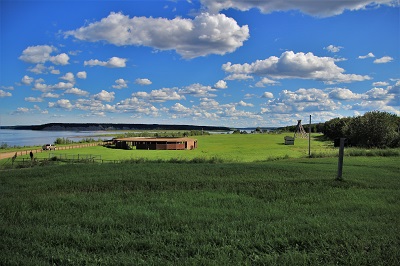Ehdaa National Historic Site of Canada
Fort Simpson, Northwest Territories

View of Ehdaa
© Madison Pilling, Liidlii Kue First Nation | Première Nation Liidlii Kue
Address :
92 Avenue, Fort Simpson, Northwest Territories
Recognition Statute:
Historic Sites and Monuments Act (R.S.C., 1985, c. H-4)
Designation Date:
2002-11-01
Dates:
-
1984 to 1987
(Construction)
-
1821 to 1921
(Significant)
-
1921 to 1921
(Significant)
-
1987 to 1987
(Significant)
Event, Person, Organization:
-
Papal visit, Pope John Paul II
(Event)
-
Signing of Treaty 11
(Event)
-
Liidlii Kue Dene
(Organization)
Other Name(s):
-
Ehdaa
(Designation Name)
-
Papal Grounds
(Other Name)
-
The Flats
(Other Name)
Research Report Number:
2002-013
Plaque(s)
Existing plaque: 92 Avenue, Fort Simpson, Northwest Territories
Ehdaa has been a traditional gathering place for the Dene since long before the arrival of Europeans. In the past, people met annually at this site to renew old ties, trade, decide on harvesting areas, resolve disputes and to participate in ceremonies of healing and thanksgiving. With the arrival of the fur trade period, the Dene used this site to camp when they came to exchange their goods. The Dene welcomed Pope John Paul II to Ehdaa on his 1987 visit and today, the Liidlii Kue Dene affirm their connection to this place with seasonal celebrations at the Drum Circle.
Description of Historic Place
Ehdaa National Historic Site of Canada is the traditional Dene meeting place on the flats at the southwestern end of Fort Simpson Island that contains facilities built for the 1987 visit of Pope John Paul II.
Heritage Value
Ehdaa was designated a national historic site because: it is a traditional gathering site for the Dene, during the pre-contact period, the Dene gathered here during their seasonal rounds to allocate land use, arrange marriages, resolve disputes through the Council of the Elders, hold puberty rites, undertake ceremonies of healing and thanksgiving, and trade goods, knowledge and technique, from the fur trade period through to the signing of Treaty 11 in 1921 and Pope John Paul II's visit in 1987, the site remains important to the Liidlii Kue Dene who renew their ongoing connection to the place with seasonal celebrations at the Drum Circle.
The heritage value of Ehdaa National Historic Site of Canada is reflected in the landscape features that support its traditional role as a seasonal gathering place for the Liidlii Kue Dene, including its easily reached central location and relics of Pope John Paul II's 1987 visit which represent a recent use of the site in its traditional role that is significant in repairing the wholeness of Dene culture and its history.
Source: HSMBC Minutes, November 2001.
Character-Defining Elements
Key features contributing to the heritage value of this site include:
the central location of the site on an island in the Mackenzie River near its confluence with the Liard River, the morphology of the site as a large flat area, evidence of traditional seasonal gatherings during the pre-contact to 1921 periods such as tipi rings, fire rings, middens, and drum circles, archaeological vestiges of facilities used to allocate land use, arrange marriages, resolve disputes, hold puberty rites, undertake ceremonies, and trade goods, knowledge and techniques, the location, forms, materials and other remnants of the Papal Grounds including the Papal Drum Circle and Papal Tipi Ring.